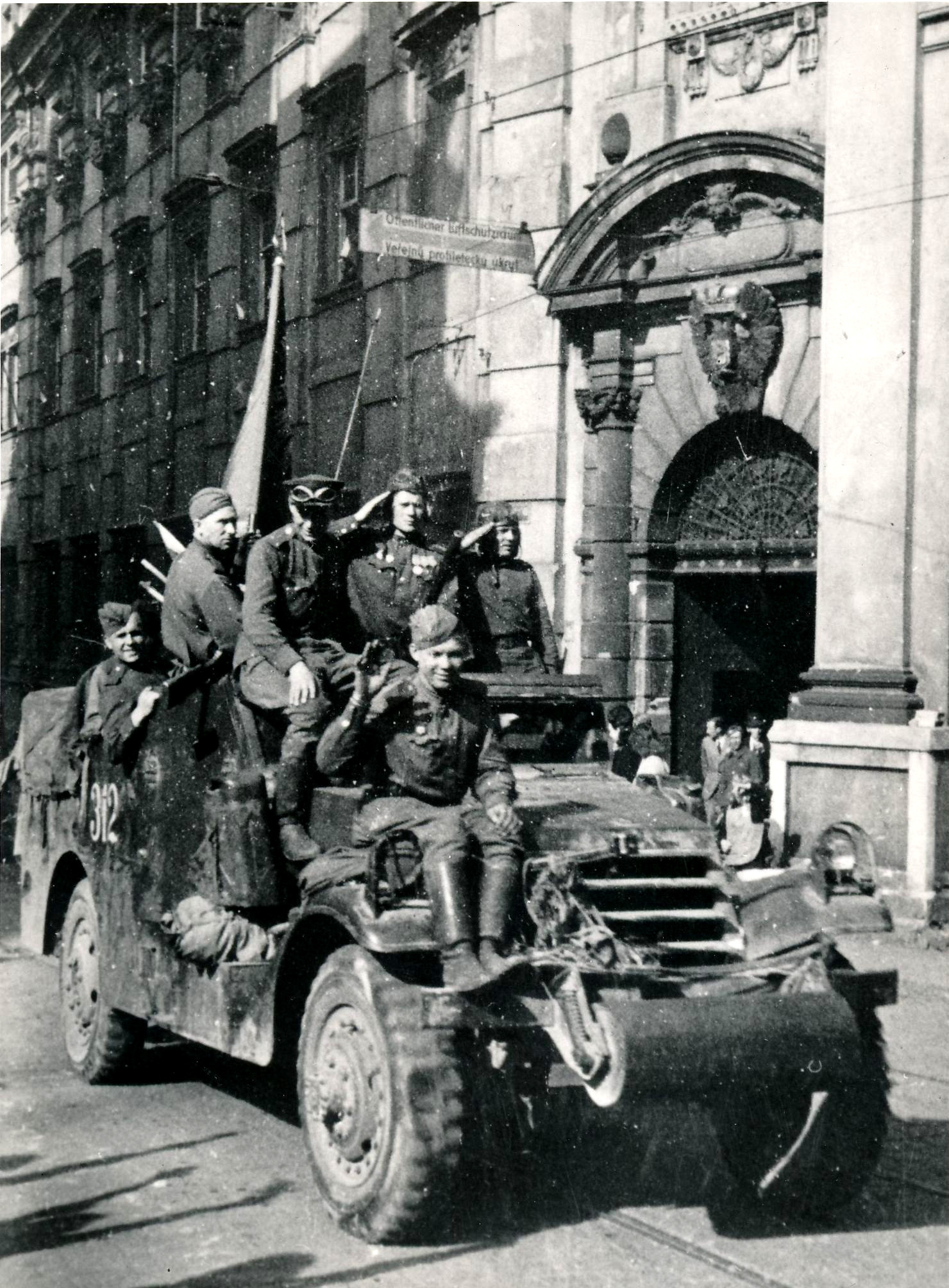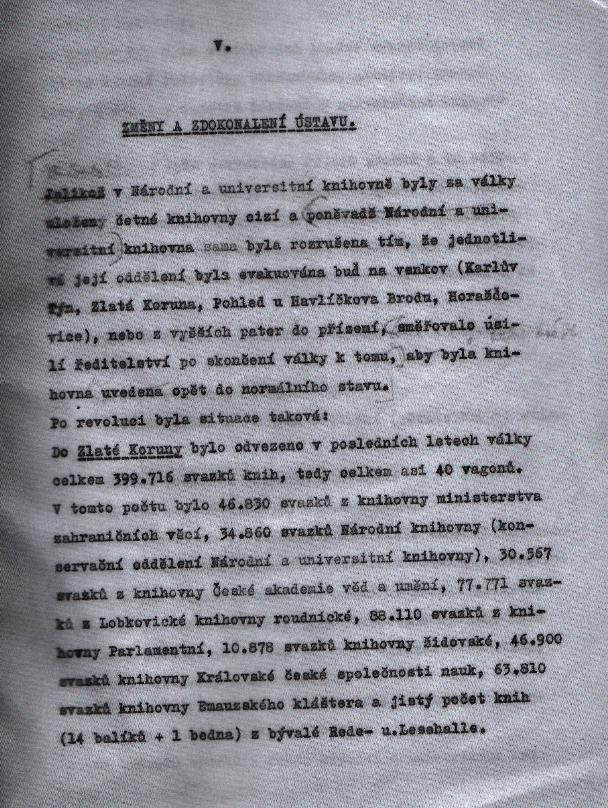Czechoslovak libraries and the National Library in the course of World War II
Published on 19 August 2015
The period of the Nazi occupation of Czechoslovakia meant great losses for Czech librarianship, brought about in several stages. After the announcement of the Munich Agreement, only a small proportion of books were successfully transported to the interior of the country. Most of the monastic and castle libraries remained in occupied territory.
The second stage was marked by the cleanup of libraries, when objectionable literature was removed from all academic, public and school libraries. These were not only the works of Jewish authors and political exiles, but also Masonic literature, literature concerning Legionaries, socialist works, and works by French, English and Russian authors, unless they had been dead for at least thirty years and were classics of world literature. In addition, astrological, prophetic, patriotic and other works were put on the unwanted list, too.
The third stage came after the closure of the universities. Charles University in Prague lost nearly half a million volumes, the Czech Technical University 60,000 titles, the Academy of Fine Arts 2,500 books, the Masaryk University about quarter of a million; the libraries of agricultural universities and the Saints Cyril and Methodius Faculty of Theology in Olomouc were not spared, either.
Libraries of various administrative and private organizations were affected, too. The library of the Ministry of Foreign Affairs was confiscated and a part of its funds transported to Berlin; the library of the Ministry of Finance was confiscated, too, together with the libraries of the Czechoslovak Embassies and consulates-general; the Lusatian library of the librarian of the National Museum, František Páta, and the library of the Náprstek Museum suffered losses, too.1
A disaster also affected the library of the Czechoslovak Sokol organization, numbering 30,000 volumes. After the organization was dissolved, its library was confiscated and some of specialized literature was selected by the Institut für Leibesübungen; the rest was destroyed in a stamp mill. To this list must be added the libraries of the individual Sokol units; there were almost 3,000, the large majority of which had their own libraries, whose collections were handed over under police supervision to be dumped, like all the productions of the Czechoslovak Sokol's publishing house.2
The total damage to Czechoslovak libraries was estimated in 1946 as follows: 9,508 public libraries were partially or totally damaged. During the war, these libraries lost 3,337,819 volumes to the value of ca 166,890,000 Czechoslovak crowns, and suffered damage to library buildings and equipment to the total amount of 12,160,000 Czechoslovak crowns.3
On 17 November 1939, by Decree of the Reich Protector, all Czech universities were closed. The Nantional and University Library was occupied by the SS and closed temporarily. Although the position of library director was formally retained and occupied between 1939 and 1945 by the brother of orientalist Bedřich Hrozný - Jindřich Hrozný - all decisions were made by the appointed Reich Commissioner. During the war, there were three - the historian Heinz Zatschek, the director of the former Prussian State Library in Berlin, Josef Becker, and, finally, the librarian Carl Wehmer. From 11 December 1939, the library reopened, but only for German students and professors. Czech readers were allowed access to the library only by permission of the German commissioner. In 1941, the library’s name was changed to the Landes- und Universitätsbibliothek and the till-then independent Slavic library was joined to it in 1942 as the Slavic department.4
The National and University Library, or rather Landes- und Universitätsbibliothek at that time, did not suffer great losses, yet it was not spared from large actions. During the war, the collections of the T. G. Masaryk library, the National Assembly Library, the part of the Ministry of Foreign Affairs Library that was not confiscated, the Lobkowicz Library in Roudnice, the Emmaus Monastery Library, the library of the Brothers of Charity, the library of the Royal Czech Society of Sciences, the Jewish Library in Olomouc and the French Grammar School Library, and others, were all deposited here. In the post war period, the books were returned to their original owners, unless they had been processed and included in the catalogue. However, there was not much time for that.5
Following the experience of the German libraries, the collections of the National and University Library were evacuated to avoid the danger of damage caused by air raids. These books found their temporary refuge in several places: at Karlštejn castle, Zlatá Koruna monastery, the village of Pohled u Havlíčkova Brodu and in Horažďovice. 399,716 volumes were taken to Zlatá Koruna – altogether filling approximately 40 railroad cars. The books from the library of the Ministery of Foreign Affairs numbered 34,830 volumes; there were 34,860 volumes from the National Library (the conservation department of the National and University Library); 30,567 volumes from the library of the Czech Academy of Sciences and Arts; 77,771 volumes from the Lobkowicz Library in Roudnice; 88,110 volumes from the Parliament Library; 10,878 volumes from the Jewish Library; 46,900 volumes from the library of the Royal Bohemian Society of Sciences; and 63,810 volumes form the Benedictine Library in Emmaus Monastery. 82,201 volumes were evacuated to Pohled from the Lobkowicz Library in Prague, together with theological literature from the National and University Library. 10,824 volumes of manuscripts, old prints, incunabula and documents belonging to the National and University Library were transported to Karlštejn. 22,620 volumes from various National and University Library departments were evacuated to Horažďovice. In addition to the evacuation of books to the rural areas, the printed materials from the upper floors of the Clementinum were moved to the lower floors and ground floor – altogether over a million volumes.6 It is clear that these tasks themselves were very demanding, considering the number of library staff, which was less than 200.7 From Pohled u Havlíčkova Brodu and Karlštejn, the books were transported back to the Clementinum by the end of 1945. The Ministry of Foreign Affairs Library books were transported back from Zlatá Koruna, while the rest of the books had to remain behind as there was a lack of vehicles to transport them. The books were taken back from Horažďovice at the beginning of 1946. The library was ready to be put back into partial operation as early as 12 May; the opening hours were from 8:00 to 12:45, while full services restarted only on 1 October, after all transportation work was finished; then the library was open from 8:00 to 12:30 and from 14:00 to 18:30.8 The library underwent personnel changes, too. The Protectorate director was removed and replaced on 9 May by Josef Bečka.
1. ČERNÁ, Marie, L. Škody na československých knihovnách a archivech, válkou zaviněné. In: Knihovna, roč. 1, č. 10, 1946, s. 301-304, zde s. 301-302.↩
2. Tamtéž, s. 303.↩
3. Lidové knihovnictví od května 1945 do května 1946. In: Knihovna, roč. 1, č. 7-8, 1946, s. 246-247, zde s. 246.↩
4. FALTYSOVÁ, Vlasta (ed.). Rukověť tištěných knihovních fondů Národní knihovny České republiky od prvotisků do konce 19. století. Praha: Národní knihovna České republiky, 2006.↩
5. ČERNÁ, Škody, s. 303.↩
6. Archiv Národní knihovny (dále jen ANK), Výroční zprávy, Výroční zpráva Národní a universitní knihovny 1945, s. 19-20.↩
7. V současnosti disponuje NK ČR zhruba 450 zaměstnanci.↩
8. ANK, Výroční zprávy, Výroční zpráva 1945↩

